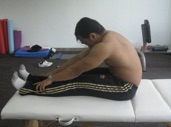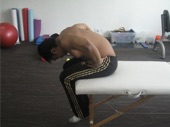Part A
- Seated on table with legs fully extended, bend forward to the fullest flexion possible.
- A C-shaped curve should be observed when viewed from the side.
- All movement should be from the spine – no knee flexion.
- Areas of “flatness” should be noted – these are regions where normal flexion of one segment on the other is absent or reduced.

Part B
- Now seated on the table with knees flexed, relaxing the hamstrings, bend forward to the fullest flexion possible with hands on crest of pelvis.
- Observing from the side again should indicate which segments remain unable to fully move into flexion.
- If there is a greater degree of flexion in this position compared to the legs straight, then the hamstrings restrictions is a factor.
- All flat areas should be charted.

Part C
- The spine now should be viewed along its length, from the head or from the lumbar region.
- Segments that are in a rotated state can be identified and direction of rotation should be noted. Rotational deviation will be observed caused by their transverse processes. The transverse processes and ribs will produce a “mounding” on the side towards which the vertebra has rotated.
